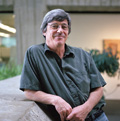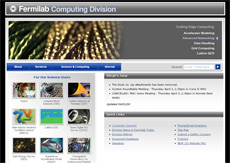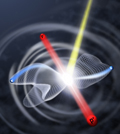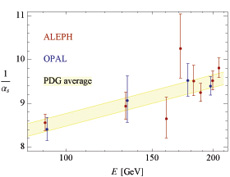|
Friday, April 4
Noon
Wellness Works Brown Bag Seminar - One West
Speaker: S. Brown (MD)
Title: Easy Strategies for Weight Loss
3:30 p.m.
DIRECTOR'S COFFEE BREAK - 2nd Flr X-Over
4 p.m.
Joint Experimental-Theoretical Physics Seminar - One West
Speaker: C. Plager, University of California, Los Angeles
Title: How Charming is the Truth? - The Search for Top Flavor Changing Neutral Currents t→Zc at CDF Run II
Saturday, April 5
Noon and 6 p.m.
Tornado and Severe Storm Seminar - Ramsey Auditorium
Monday, April 7
THERE WILL BE NO PARTICLE ASTROPHYSICS SEMINAR THIS WEEK
3:30 p.m.
DIRECTOR'S COFFEE BREAK - 2nd Flr X-Over
4 p.m.
All Experimenters' Meeting - Curia II
Special Topic: CMS Installation and Commissioning
Click here for NALCAL,
a weekly calendar with links to additional information. |
Friday, April 4
- Chunky vegetable soup w/orzo
- Buffalo chicken wings
- Cajun breaded catfish
- Teriyaki pork stir-fry
- Honey mustard ham & Swiss
- Assorted pizza slices
- Panini carved turkey
*Carb Restricted Alternative
Wilson Hall Cafe Menu |
|
Wednesday, April 9
Lunch
- Moroccan game hens
- Couscous w/almonds & raisins
- Julienne of carrots
- Pear strudel
Thursday, April 10
Dinner
- Closed
Chez Leon Menu
Call x4598 to make your reservation. |
|
|
Hugh Montgomery named director of Jefferson Lab
 |
| Hugh Montgomery |
Jefferson Science Associates announced Thursday that Hugh Montgomery will become the new director of DOE's Thomas Jefferson National Accelerator Facility in Newport News, Virginia. Currently the Associate Director for Research at Fermilab, Montgomery will take charge of Jefferson Lab on Sept. 2.
"Hugh Montgomery is a superb choice for the laboratory," said Dr. Raymond L. Orbach, Under Secretary for Science at DOE. "As director, he will lead a world-class center that can enable scientists to probe the innermost secrets of the atomic nucleus. I am confident that under Dr. Montgomery, Jefferson Lab will continue its outstanding scientific leadership."
Montgomery has spent almost 25 years at Fermilab and has served in his current position since 2002.
"We will miss Mont's great leadership, his profound knowledge of physics, his drive and great sense of humor," said Fermilab Director Pier Oddone. "It is a great opportunity for Mont, for Jefferson Lab and for us at Fermilab to build closer ties with Jefferson Lab."
In his new role, Montgomery also will serve as president of Jefferson Science Associates, a joint venture between the Southeastern Universities Research Association and CSC Applied Technologies, that manages and operates Jefferson Lab for DOE.
"Jefferson Lab and DOE are fortunate to have Dr. Montgomery coming on board as the new director," said John T. Casteen, president of the University of Virginia and chair of the JSA Board of Directors. "He is both a distinguished scientist and an experienced leader and manager within the laboratory system."
With a Ph.D. in physics from Manchester University in England, Montgomery has an extensive background in both nuclear and particle physics. His work at Fermilab focuses on particle physics, which seeks to understand the fundamental components of our universe and how they interact. Montgomery was involved with muon scattering experiments at Fermilab and CERN in Geneva, Switzerland. He was also involved in the DZero Experiment on the Fermilab Tevatron at the time of the observation of the top quark. In his role as associate director, he oversees the particle physics and particle astrophysics research programs at the laboratory.
"After almost 25 years at Fermilab, this move certainly represents a major change in my life," Montgomery said. "The new position will be an enormous challenge for me but also an enormous opportunity to which I am looking forward. The provision of research facilities for a broad international community of physicists is something at which both Fermilab and Jefferson Lab excel. I hope I prove worthy of the great team at Jefferson."
Read more
|
Computing Division launches new, user-friendly Web site

New Computing Division Web site
The Computing Division launched a new Web site Thursday. The site has been under development for
several months and includes an updated look and significant
reorganization of the Web site's content. What does this mean to you?
Hopefully, it means that you can find things more easily. But it also
means that if you had bookmarks to locations in the old site, they might
not work anymore. We have started a FAQ to answer any questions you
might have about the new site and how to navigate it. But of course, if
your questions are not answered by the FAQ, you can't find something
or you see an error, please contact the Computing Division Helpdesk. We hope you like
the new site!
|
Massively parallel: NERSC, OSG and HPC
 |
| In 2007, climate simulations dominated OSG allocation of parallel computing time at NERSC; in 2008 parallel chemistry codes-like the one used for this simulation of the double photoionization of a hydrogen molecule-are seen as a growth area.
Image courtesy of courtesy of Wim Vanroose |
The Open Science Grid has long recognized that there is strength in numbers. This can mean large numbers of computing elements, a growing number and diversity of users, or the increasingly wealth and diversity of available resources.
A new facet in the OSG crown is a 20,000-core Cray XT4 parallel computer at the National Energy Research Scientific Computing Center. Called Franklin, it joined the list of OSG resources in 2007.
NERSC was the first OSG member to bring large-scale parallelism to the OSG and is the largest OSG resource, with approximately 25,000 cores in service.
Read more
- D. Skinner, W. Kramer, J. Hules and D. Olson, NERSC
|
Matter-antimatter split hints at physics breakdown
From Scientific American, April 3, 2008
What's the matter with antimatter? New data may hold the answer.
Nature may have handed scientists a new clue in a longstanding mystery: how matter beat out antimatter for dominance of the universe. Early data from twin experiments at the Tevatron, the world's reigning particle accelerator at Fermi National Accelerator Laboratory in Batavia, Ill., suggest an unexpected chink in the hugely successful standard model of particle physics.
The twist comes from odd behavior in a particle called the BS, which flips back and forth between its matter and antimatter forms three trillions times per second. Researchers believe that such a breakdown, known as CP violation, is required to explain why matter is so abundant.
Researchers say the finding is well worth following up to make sure it is not a random clump in the data, as frequently happens in particle physics experiments. "This is exciting, definitely," says Fermilab physicist Jacobo Konigsberg, cospokesperson for CDF, one of two detectors that may have glimpsed the effect.
Read more
|
|
|
The shape of the strong interaction

The dependence of the strong coupling αs on the energy E. The points and error bars show 1/αs as calculated by Becher and Schwartz based on data gathered by the experiments ALEPH and OPAL. The yellow band is the Quantum Chromodynamics prediction based on the world average for αs by the Particle Data Group.
The strong force, which binds quarks and gluons inside protons and neutrons, becomes weaker at higher energies. In high-energy collisions, the interaction of quarks and gluons becomes so weak that they almost behave as free particles. Physicists call this curious property of the strong interaction "asymptotic freedom." Quantum Chromodynamics, the theory describing the strong interaction, exactly predicts how much the bond of the particles weakens as the energy of their interaction increases.
A recent calculation by Thomas Becher, of Fermilab, and Matthew D. Schwartz, of Johns Hopkins University, has put this prediction of Quantum Chromodynamics to a stringent test. They calculated the event shapes of high-energy collisions and compared their results with measured thrust distributions at various energies. The comparison determined with unprecedented precision the strong coupling αs, which specifies the strength of the bond between quarks and gluons. Last year, a higher-order calculation had reduced the perturbative uncertainty in the determination of αs from high-energy event shapes from 4 to 2 percent. The calculation of Becher and Schwartz slashed the uncertainty even further, down to 1 percent.
Thrust describes the shape created by particle tracks emerging from a high-energy collision event. For example, a collision in which all particle tracks are aligned and create a pencil-like shape has a thrust of T=1, while a collision that produces a spherically symmetric shape has a thrust of T=1/2. In the past, uncertainties in the theoretical calculations have been limiting the precision of the value of αs extracted from thrust measurements. The increased theoretical accuracy of the result of Becher and Schwartz is due to a new technique introduced in the calculation. While previous methods only allowed the resummation of next-to-leading logarithmic terms, their approach yields a result that is valid to next-to-next-to-next-to-leading logarithmic accuracy.
Using data gathered by the experiments ALEPH and OPAL at the Large Electron-Positron collider at CERN, Becher and Schwartz obtained αs(MZ) = 0.1172 ± 0.0010 ± 0.0008 ± 0.0012 ± 0.0012 at an energy equivalent to the mass of the Z boson, MZ. The uncertainties listed respectively are statistical, systematic, hadronic and perturbative.
 |
| Matthew Schwartz |
The new result is the most precise determination of αs at highest energies. It agrees with the world average of the Particle Data Group, αs(MZ)= 0.1176 ± 0.0020, which mostly relies on the theoretical extrapolation of low-energy data to MZ. The consistency of these two values confirms that the strong interaction weakens at high energy exactly in the way predicted by Quantum Chromodynamics.

Thomas Becher
Image courtesy of Callie Lipkin
Result of the Week Archive
|
|
Have a safe day!
Tom Skilling Tornado Seminar Saturday
Meteorologist Tom Skilling will host two presentations of his annual Tornado and Severe Storm Seminar at noon and 6 p.m. on Saturday, April 5 in Fermilab's Ramsey Auditorium. Seating is first come, first serve and fills up fast. See the event Web site for more information.
English country dancing Saturday
English country dancing will meet, exceptionally, this Saturday (not Sunday as usual), April 5, at Kuhn Barn, from 2 to 5 p.m. Newcomers are always welcome and no partner is required. There will be a potluck supper following starting at 5:30 p.m. and then an evening of Scottish country dancing in honor of Tartan Day beginning at 7 p.m. For more information please contact folkdance@fnal.gov or call 630-584-0825 or 630-840-8194. There will be no English country dancing on Sunday, April 6. The next meeting will be Sunday afternoon, May 3.
Kyuki-Do Martial Arts class begins Monday
Kyuki-Do is a mixed martial arts system based on Taekwondo that leads to a practical method of self-defense. It will teach you balance, power, and self control. Classes are held for six weeks on Mondays and Wednesdays from 5 - 6 p.m. at the Recreation Facility in the Village. You need to register through the Recreation Office and also be a member of the Recreation Facility. The cost is $45 per six week session.
Brown Bag Seminar Friday
The Wellness Works Committee presents a Brown Bag Seminar entitled "Easy Strategies for Weight Loss" by Sheron Brown, M.D. Friday, April 4, 2008, from noon to 1 p.m. in One West. Dr. Brown specializes in preventive medicine.
Computer programming course
"Fine Points of C++ Pointers: Dumb, Smart, and Smarter," the second course in the current series of "Selected Topics in Computer Programming," is offered on Thursday, April 10. Aimed at programmers with C++ experience, it will deal in depth with issues related to pointer manipulation in C++ programs. Attendees will learn best-practice techniques of resource management in modern standard C++, which will prepare them for related new techniques that will become available in the next C++ standard.
The course is free and participants will receive TRAIN credit. Course registration is now open. Future courses will occur at two-week intervals.
NALWO lunch April 9
The next NALWO luncheon is Wednesday, April 9, at noon at Chez Leon. This is a chance to meet other laboratory women, network or just relax over a meal. The cost is $14. Anyone interested can RSVP by Friday, April 4, to Marjorie Appel via e-mail or by phone at (630) 293-9349.
Classifieds
Find new classified ads on Fermilab Today.
Additional Activities
|
|